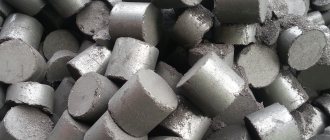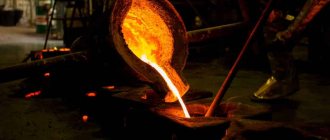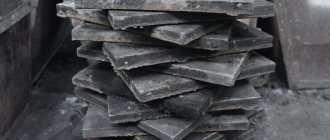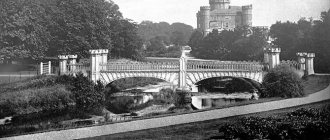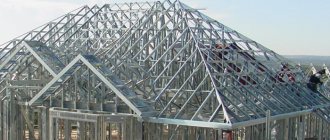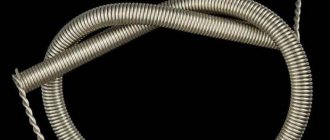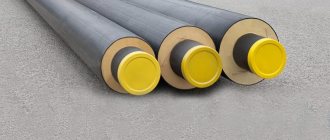Cast iron, which has higher ductility compared to cast iron with flake graphite, is called malleable. Malleable cast irons containing 2.4...2.9% carbon are produced by graphitizing annealing of white cast iron castings. Cast iron parts are produced only by casting . The thickness of the casting section is limited to 40...50 mm.
Depending on the composition of the microstructure of the metal base, malleable cast iron is divided into classes :
- ferritic (F);
- pearlitic (P).
The standard establishes the following grades of ductile iron castings:
- KChZO-6 , KChZZ-8 , KCh35-10 , KCh37-12 ferritic class, characterized by ferritic or ferrite-pearlite microstructure of the metal base;
- KCh45-7 , KCh50-5 , KCh55-4 , KCh60-3 , KCh65-3 , KCh70-2 , KCh80-1.5 pearlite class, characterized mainly by the pearlite microstructure of the metal base.
The brand symbol includes:
- the letters “KCH” before the numbers are malleable cast iron,
- the first two digits indicate the value of the minimum tensile strength in MPa-10″',
- numbers after the dash - the value of the relative elongation in %,
- letters after numbers - cast iron class.
Malleable cast iron is used for products operating under dynamic loads.
The standard provides for the following grades of cast iron with lamellar graphite for castings: SCh10; SCH15; SCh20; SCH25; SCh30; SCH35. At the request of the consumer, cast iron grades SCh18 are allowed for the manufacture of castings; SCh21; SCH24. The symbol of the brand includes the letters “СЧ” - gray cast iron and a digital designation of the value of the minimum tensile strength in MPa · 10-1.
Up
Story
This material has been known since the 4th century BC. e. Its Chinese roots date back to the 6th century. BC e. In Europe, the first mentions of industrial production of the alloy date back to the 14th century, and in Russia - to the 16th century. But the technology for producing malleable cast iron was patented in Russia in the 19th century. Later developed by A.D. Annosov.
Since gray cast irons are limited in use due to low mechanical properties, and steels are expensive and have low hardness and durability, the question arose about creating a metal that is reliable, durable, hard, and at the same time has increased strength and a certain ductility.
Cast iron cannot be forged, but due to its ductile characteristics, it lends itself to certain types of pressure processing (for example, stamping).
Material KCh35-10 Chelyabinsk
Not a single production can operate without steel, be it heavy engineering or the manufacture of household electrical appliances. There are many brands of this product, as well as a large number of dispensing forms. Our company sells KCh35-10 material in large quantities and with a minimal margin. To clarify the properties and characteristics of a particular brand, you can contact the company’s managers.
Like all products, KCh35-10 material is purchased from leading manufacturers. Therefore, we are ready to provide a quality guarantee with full responsibility. The minimum number of intermediaries determines the low cost. Coupled with fast delivery, this enables our business partners to conduct stable and mutually beneficial cooperation.
In addition to tempering, in the form of one or another part (blank), our company carries out metal processing. All events undergo strict control for compliance with GOST and rules. The specialists of our company carry out such work as galvanizing, creating parts according to customer drawings, producing castings, manufacturing various profiles and much more.
Having the latest equipment and vast experience in our arsenal, we can offer product testing for a number of parameters, such as strength characteristics, chemical composition, alloy purity, and so on.
Each buyer is offered a huge range of products in various formats, as well as current services and works. To quickly understand and choose a product that meets your needs, you need to contact the company manager and receive detailed information on all issues of interest.
Production
The main method is smelting in blast furnaces.
Initial products for blast furnace processing:
- Charge is iron ore containing metal in the form of ferum oxides.
- Fuel - coke and natural gas.
- Oxygen is injected through special tuyeres.
- Fluxes are chemical formations based on manganese and (or) silicon.
Stages of blast furnace smelting:
- Reduction of pure iron by chemical reactions of iron ore with oxygen supplied through tuyeres.
- Combustion of coke and formation of carbon oxides.
- Carburization of pure iron in reactions with CO and CO2.
- Saturation of Fe3C with manganese and silicon, depending on the required output properties.
- Draining the finished metal into molds through cast iron tap holes; draining slag through slag tapholes.
At the end of the blast furnace operating cycle, they produce cast iron, slag and blast furnace gases.
Metal products from blast furnace production
Depending on the cooling rate, microstructure, saturation with carbon and additives, it is possible to obtain several types of cast iron:
- Convertible (white): carbon in bound form, primary cementite. They are used as raw materials for smelting and processing of other iron-carbon alloys. Up to 80% of all blast furnace alloy produced.
- Foundry (gray): carbon in the form of completely or partially free graphite, namely its plates. Used for the production of low-critical body parts. Up to 19% of produced blast furnace casting.
- Special: saturated with ferroalloys. 1-2% of the type of production under consideration.
Malleable cast iron is produced by heat treatment of pig iron.
Theory of iron-carbon structures
Carbon and ferum can form several different types of alloys according to the type of crystal lattice, which is reflected in the microstructure variant.
- Solid solution of penetration into α-iron – ferrite.
- Solid solution of penetration into γ-iron – austenite.
- The chemical formation of Fe3C (bound state) is cementite. Primary is formed by rapid cooling from a liquid melt. Secondary – slower temperature decrease, from austenite. Tertiary - gradual cooling, made of ferrite.
- A mechanical mixture of ferrite and cementite grains is pearlite.
- A mechanical mixture of pearlite or austenite grains and cementite is ledeburite.
Cast iron is characterized by a special microstructure. Graphite can be in a bound form and form the above structures, or it can be in a free state in the form of various inclusions. The properties are influenced by both the main grains and these formations. Graphite fractions in metal are plates, flakes or balls.
The lamellar shape is characteristic of gray iron-carbon alloys. It makes them fragile and unreliable.
Malleable cast iron has flocculent inclusions, which has a positive effect on their mechanical properties.
The spherical structure of graphite further improves the quality of the metal, increasing its hardness, reliability, and withstanding significant loads. High-strength cast iron has these characteristics. Malleable cast iron derives its properties from a ferritic or pearlitic base with the presence of flake-like graphite inclusions.
Preparation of ferritic ductile iron
It is produced from a white pigment hypoeutectoid low-carbon alloy by annealing ingots with a carbon content of 2.4-2.8% and the corresponding presence of additives (Mn, Si, S, P). The wall thickness of the annealed parts should be no more than 5 cm. For castings of significant thickness, graphite has the shape of plates and the desired properties are not achieved.
To obtain malleable cast iron with a ferritic base, the metal is placed in special boxes and sprinkled with sand. Tightly closed containers are placed in heating ovens. Carry out the following sequence of actions during annealing:
- The structures are heated in ovens to a temperature of 1,000 °C and left to remain at constant heat for a period of 10 to 24 hours. As a result, primary cementite and ledeburite decompose.
- The metal is cooled to 720 °C along with the furnace.
- They are kept at a temperature of 720 °C for a long time: from 15 to 30 hours. This temperature ensures the decomposition of secondary cementite.
- At the final stage, it is again cooled together with the working stove to 500 ˚C, and then taken out into the air.
This technological annealing is called graphitizing.
After the work, the microstructure of the material is ferrite with flake-like graphite grains. This type is called “black-hearted” because the fracture is black.
Preparation of pearlitic malleable cast iron
This is a type of iron-carbon alloy, which also originates from hypoeutectoid white, but the carbon content in it is increased: 3-3.6%. To obtain castings with a pearlite base, they are placed in boxes and sprinkled with crushed powdered iron ore or scale. The annealing procedure itself is simplified.
- The metal temperature is increased to 1,000 °C and held for 60-100 hours.
- The structures are cooled with a furnace.
Due to smoldering under the influence of heat, diffusion occurs in the metal environment: the graphite released in cementite decomposition partially leaves the surface layer of the annealed parts, settling on the surface of the ore or scale. A softer, more viscous and ductile top layer of “white-hearted” malleable cast iron with a hard center is obtained.
Such annealing is called incomplete. It ensures the decomposition of cementite and ledeburite into lamellar pearlite with the corresponding graphite. If granular pearlitic malleable cast iron with higher values of impact strength and ductility is required, additional heating of the material to 720 ˚C is used. In this case, pearlite grains with flake-like graphite inclusions are formed.
Malleable iron
Malleable iron castings are produced by graphitizing annealing of white cast iron of a certain chemical composition, which ensures the formation of compact graphite during the annealing process, which gives the ductile iron increased mechanical properties (tensile strength σB, elongation δ and impact strength αH).
The recommended chemical composition of malleable cast iron is characterized by a reduced content of graphitizing elements C=2.4-2.9%; Si=1.0-1.6%; C+Si=3.6-4.2%, which is due to the need to obtain castings from malleable iron in a cast state with 100% chill throughout the entire cross-section of the casting, for the simple reason that if there is lamellar graphite in the cast iron structure, in the process Subsequent annealing will result in the formation of flake graphite (i.e., gray cast iron), rather than the compact nature of ductile cast iron.
It is customary to distinguish between black-core malleable cast iron, obtained by graphitizing annealing (technology used in Ukraine) and white-core malleable cast iron, obtained by decarburizing annealing in an oxidizing environment (usually the castings are placed in containers mixed with iron ore, t=1000-1050°C, τ=60- 70 h). Thin-walled castings from white malleable cast iron are produced in France, Germany, Italy and other countries; the main advantages of such cast iron are increased viscosity and suitability for welding without preliminary and subsequent heat treatment.
Heat treatment
Graphitizing annealing is an integral technological operation in the process of producing malleable cast iron. The main purpose is to carry out graphitization, i.e. separation of graphite from cementite, and the process can proceed in two ways: complete graphitization of cementite, producing a ferritic metal matrix, and partial graphitization of primary and ledeburite cementite, producing pearlite or pearlite-ferrite metal matrix.
Regardless of the chosen option, graphitizing annealing is carried out in two stages:
Rice. 1: Scheme of graphitizing annealing of malleable cast iron
- the stage includes: heating to a temperature of 930-1050°C at a rate of 200-300°C/h; holding for ~10 hours. At this stage, decomposition of primary and ledeburite cementite occurs, resulting in the formation of an austenite matrix with inclusions of flake (compact) graphite (see Fig. 1). This is followed by a decrease in temperature to ~760°C (at a rate of 50-65°C/h), i.e. to a temperature slightly above the onset of the eutectoid transformation.
- the stage involves slow cooling at a rate of no higher than 5°C/h throughout the entire eutectoid transformation range, up to ~700°C. At this stage, the cementite included in the perlite decomposes. The final microstructure of cast iron depends on the parameters of the second stage: short-term exposure (~5 hours) entails the formation of a pearlite structure of the metal matrix with inclusions of compact graphite, around which a ferrite rim is located; long exposure for 20-40 hours leads to the formation of a ferritic metal matrix with inclusions of compact graphite, which is clearly shown in Fig. 1.
The main disadvantage of the technical process for producing malleable cast iron is the lengthy heat treatment process, which, given the current high prices for electricity, leads to significant costs. To reduce the annealing time, malleable cast iron is subjected to modification and microalloying with aluminum (0.01%), boron (0.003%), titanium (0.03%), bismuth (0.003%), which leads to an increase in graphitization centers in the melt and a decrease in the stability of cementite .
Advantages of malleable cast iron:
- Combination of high mechanical properties with high cutting machinability (compact graphite contributes to chip brittleness and is a lubricant)
- Homogeneous structure over the entire cross-section of the casting
- No internal stresses in castings
- Ability to withstand high alternating loads
- High corrosion resistance
Malleable cast iron is used for the production of small thin-walled castings (3-50 mm) for critical purposes, operating under dynamic alternating loads in the automotive, tractor and agricultural machinery industries for the manufacture of gearboxes, drive mechanism parts, chassis, levers, crankshafts and camshafts, clutch parts , diesel engine pistons, valve rocker arms, fittings, etc.
Standards
Technical characteristics of malleable cast iron for the manufacture of castings are regulated by GOST 1215-79 “Ductile iron castings. General technical conditions".
Marking
Malleable cast iron is marked with the letters KCH, followed by two numbers indicating the tensile strength σB (in kgf/mm2), and after them, separated by a hyphen, followed by one or two numbers displaying the relative elongation δ (in %), ending with a hyphen markings with the letters F or P, indicating the class of cast iron: ferritic or pearlitic. For example, KCh 37-12-F means malleable cast iron of the ferritic class with a tensile strength of at least 37 kg/mm2 and a relative elongation of at least 12%.
Classification of malleable cast iron
Depending on the microstructure of the metal matrix, ductile cast iron is divided into ferritic (F) and pearlitic (P):
- Malleable cast iron of the ferritic class with a ferritic or ferrite-pearlite microstructure of the metal matrix is produced in the following grades: KCh 30-6, KCh 33-8, KCh 35-10, KCh 37-12
- Malleable cast iron of the pearlitic class with a pearlitic microstructure of the metal matrix is produced in the following grades: KCh 45-7, KCh 50-5, KCh 55-4, KCh 60-3, KCh 65-3, KCh 70-2, KCh 80-1.5
Mechanical properties
The mechanical properties of the material of castings made of malleable cast iron of ferritic and pearlitic classes must meet the requirements of GOST 1215-79 given in table. 1.
Table 1: Mechanical properties of ductile cast iron according to GOST 1215-79
Note: * By agreement between the manufacturer and the consumer, a reduction of 1% is allowed.
Chemical composition
The recommended chemical composition of malleable cast iron according to GOST 1215-79 is given in table. 2.
Table 2: Chemical composition of malleable cast iron according to GOST 1215-79
Properties, markings and applications of ferritic ductile iron
Long-term “simmering” of the metal in a furnace results in the complete disintegration of cementite and ledeburite into ferrite. Thanks to technological tricks, an alloy with a high carbon content is obtained - a ferritic structure characteristic of low-carbon steel. However, carbon itself does not disappear anywhere - it goes from a state bound to iron to a free one. Temperature changes the shape of graphite inclusions to flocculent.
The ferritic structure causes a decrease in hardness, an increase in strength values, and the presence of characteristics such as impact strength and ductility.
Marking of malleable cast iron of ferritic class: KCh30-6, KCh33-8, KCh35-10, KCh37-12, where:
KCh – designation of variety – malleable;
30, 33, 35, 37: σв, 300, 330, 350, 370 N/mm2 – the maximum load that it can withstand without collapsing;
6, 8, 10, 12 – relative elongation, δ, % – ductility indicator (the higher the value, the more the metal can be processed by pressure).
Hardness – about 100-160 HB.
In terms of its performance, this material occupies a middle position between steel and gray iron-carbon alloy. Malleable cast iron with a ferritic base is inferior to pearlitic in terms of wear resistance, corrosion and fatigue strength, but is higher in mechanical endurance, ductility, and casting characteristics. Due to its low price, it is widely used in industry for the manufacture of parts operating under low and medium loads: gears, crankcases, rear axles, plumbing.
KCh35-10 Chelyabinsk
| Brand: | KCh35-10 |
| Classification: | Malleable cast iron |
| Addition: | Ferritic cast iron, cupola-electric furnace smelting method |
| Application: | parts operating under high static and dynamic loads |
| Foreign analogues: | Known |
Chemical composition in % of material KCh35-10
GOST 1215-79
| C | Si | Mn | S | P | Cr | — |
| 2.5- 2.8 | 1.1- 1.3 | 0.3- 0.6 | up to 0.2 | up to 0.12 | up to 0.06 | C+Si = 3.6-4 |
Mechanical properties at T=20oC of the KCh35-10 material.
| Assortment | Size | Eg. | sв | sT | d5 | y | KCU | Thermal change |
| — | mm | — | MPa | MPa | % | % | kJ/m2 | — |
| Castings, GOST 1215-79 | 333 | 10 |
| Hardness KCh35-10, GOST 1215-79 | HB 10 -1 = 100-163 MPa |
Physical properties of the material KCh35-10.
| T | E 10- 5 | a 10 6 | l | r | C | R 10 9 |
| hail | MPa | 1/Grad | W/(m deg) | kg/m3 | J/(kg deg) | Ohm m |
| 20 | 1.66 |
Foreign analogues of material KCH35-10
Attention!
Both exact and closest analogues are indicated. GTS35-10
| USA | Germany | Japan | France | England | Italy | Sweden | Poland | Czech | Austria |
| — | DIN,WNr | JIS | AFNOR | B.S. | UNI | SS | PN | CSN | ONORM |
| 32510 | |||||||||
Designations:
| Mechanical properties : | |
| sв | -Short-term strength limit, [MPa] |
| sT | - Proportional limit (yield strength for permanent deformation), [MPa] |
| d5 | -Elongation at break, [%] |
| y | -Relative narrowing, [%] |
| KCU | -Impact strength, [kJ/m2] |
| HB | -Brinell hardness, [MPa] |
| Physical properties: | |
| T | -Temperature at which these properties were obtained, [Deg] |
| E | -Elastic modulus of the first kind, [MPa] |
| a | -Coefficient of thermal (linear) expansion (range 20o-T), [1/degree] |
| l | -Thermal conductivity coefficient (heat capacity of the material), [W/(m deg)] |
| r | -Material density, [kg/m3] |
| C | -Specific heat capacity of the material (range 20o-T), [J/(kg deg)] |
| R | -Specific electrical resistivity, [Ohm m] |
KCh35-10 - Malleable cast iron KCh35-10 - chemical composition, mechanical, physical and technological properties, density, hardness, application
Affordable metal products
KCh35-10
Properties, marking and application of pearlitic ductile iron
Due to incomplete annealing, primary, secondary cementites and ledeburite have time to completely dissolve in austenite, which at a temperature of 720 °C turns into pearlite. The latter is a mechanical mixture of grains of ferrite and tertiary cementite. Actually, part of the carbon remains in a bound form, determining the structure, and part is “released” into flake-like graphite. In this case, perlite can be lamellar or granular. In this way, pearlitic malleable cast iron is formed. Its properties are due to its rich, harder and less pliable structure.
These, in comparison with ferritic ones, have higher anti-corrosion and wear-resistant properties, their strength is much higher, but their casting characteristics and ductility are lower. Compliance to mechanical stress is increased superficially, while maintaining the hardness and viscosity of the core of the product.
Marking of malleable cast irons of pearlitic class: KCh45-7, KCh50-5, KCh56-4, KCh60-3, KCh65-3, KCh70-2, KCh80-1.5.
The first number is the designation of strength: 450, 500, 560, 600, 650, 700 and 800 N/mm2, respectively.
The second is the designation of plasticity: relative elongation δ,% – 7, 5, 4, 3, 3, 2 and 1.5.
Pearlitic malleable cast iron has found application in mechanical engineering and instrument making for structures operating under heavy loads - both static and dynamic: camshafts, crankshafts, clutch parts, pistons, connecting rods.
KCh35-10 Ekaterinburg
| Brand: | KCh35-10 |
| Classification: | Malleable cast iron |
| Addition: | Ferritic cast iron, cupola-electric furnace smelting method |
| Application: | parts operating under high static and dynamic loads |
| Foreign analogues: | Known |
Chemical composition in % of material KCh35-10
GOST 1215-79
| C | Si | Mn | S | P | Cr | — |
| 2.5- 2.8 | 1.1- 1.3 | 0.3- 0.6 | up to 0.2 | up to 0.12 | up to 0.06 | C+Si = 3.6-4 |
Mechanical properties at T=20oC of the KCh35-10 material.
| Assortment | Size | Eg. | sв | sT | d5 | y | KCU | Thermal change |
| — | mm | — | MPa | MPa | % | % | kJ/m2 | — |
| Castings, GOST 1215-79 | 333 | 10 |
| Hardness KCh35-10, GOST 1215-79 | HB 10 -1 = 100-163 MPa |
Physical properties of the material KCh35-10.
| T | E 10- 5 | a 10 6 | l | r | C | R 10 9 |
| hail | MPa | 1/Grad | W/(m deg) | kg/m3 | J/(kg deg) | Ohm m |
| 20 | 1.66 |
Foreign analogues of material KCH35-10
Attention!
Both exact and closest analogues are indicated. GTS35-10
| USA | Germany | Japan | France | England | Italy | Sweden | Poland | Czech | Austria |
| — | DIN,WNr | JIS | AFNOR | B.S. | UNI | SS | PN | CSN | ONORM |
| 32510 | |||||||||
Designations:
| Mechanical properties : | |
| sв | -Short-term strength limit, [MPa] |
| sT | - Proportional limit (yield strength for permanent deformation), [MPa] |
| d5 | -Elongation at break, [%] |
| y | -Relative narrowing, [%] |
| KCU | -Impact strength, [kJ/m2] |
| HB | -Brinell hardness, [MPa] |
| Physical properties: | |
| T | -Temperature at which these properties were obtained, [Deg] |
| E | -Elastic modulus of the first kind, [MPa] |
| a | -Coefficient of thermal (linear) expansion (range 20o-T), [1/degree] |
| l | -Thermal conductivity coefficient (heat capacity of the material), [W/(m deg)] |
| r | -Material density, [kg/m3] |
| C | -Specific heat capacity of the material (range 20o-T), [J/(kg deg)] |
| R | -Specific electrical resistivity, [Ohm m] |
KCh35-10 - Malleable cast iron KCh35-10 - chemical composition, mechanical, physical and technological properties, density, hardness, application
Affordable metal products
KCh35-10
Heat treatment
The material obtained as a result of heat treatment, namely annealing, can be repeatedly subjected to temperature influence methods. Their main goal is to further increase strength, wear resistance, resistance to corrosion and aging.
- Hardening is used for structures requiring high hardness and toughness; It is produced by heating up to 900 ˚С, the parts are cooled at an average speed of about 100 ˚С/sec using machine oil. This is followed by high tempering with heating to 650˚C and cooling in air.
- Normalization is used for small, simple parts by heating in an oven to 900 ˚C, standing at this temperature for 1 to 1.5 hours and then cooling in air. Provides troostite granular perlite, its hardness and reliability during friction and wear. It is used to produce anti-friction malleable cast irons with a pearlite base.
- Annealing is carried out repeatedly during the manufacture of antifriction: heating up to 900 ˚C, long-term exposure at this heat, cooling with the furnace. A ferritic or ferritic-pearlitic structure of anti-friction malleable cast iron is provided.
Heating of cast iron products can be carried out locally or comprehensively. For local applications, high-frequency currents or an acetylene flame are used (hardening). For complex – heating furnaces. With local heating, only the top layer is hardened, thereby increasing its hardness and strength, but maintaining the ductility and viscosity of the core.
It is important to point out here that forging cast iron is impossible not only due to insufficient mechanical characteristics, but also due to its high sensitivity to sudden temperature changes, which is inevitable when quenching with water cooling.
Structure, properties and application of cast irons (page 5)
High-strength cast irons are used for casting parts for critical purposes, for replacing cast and forged steel parts made of ductile and ordinary gray cast iron of crankshafts, rolling mill rolls, plain bearings, chabots, hammers, valve parts, compressors.
4.2.3. Malleable cast irons
malleable
called
cast iron with flake graphite
, obtained from white cast iron as a result of special
graphite-forming annealing
(simmering).
Table 4. Chemical composition (in%) of high-strength cast irons
| Cast iron grades | WITH | Si | Mn | P | S | Cr | Other |
| no more | |||||||
| HF 35 | 3,3-3,8 | 1,9-2,9 | 0.2-0.6 | 0,1 | 0,02 | 0,05 | — |
| HF 40 | 3,3-3,8 | 1,9-2,9 | 0.2-0.6 | 0,1 | 0,02 | 0,1 | — |
| HF 45 | 3,3-3,8 | 1,9-2,9 | 0.3-0.6 | 0,1 | 0,02 | 0,1 | — |
| HF 50 | 3,2-3,7 | 1,9-2,9 | 0.3-0.7 | 0,1 | 0,02 | 0,15 | — |
| HF 60 | 3,2-3,6 | 2,4-2,6 | 0.4-0.7 | 0,1 | 0,02 | 0,15 | 0.3 Cu 0.4 Ni |
| HF 70 | 3,2-3,6 | 2,6-2,9 | 0.4-0.7 | 0,1 | 0,015 | 0,15 | 0.4 Cu 0.6 Ni |
| HF 80 | 3,2-3,6 | 2,6-2,9 | 0.4-0.7 | 0,1 | 0,01 | 0,15 | 0.6 Cu 0.6 Ni |
| HF 100 | 3,2-3,6 | 3,0-3,8 | 0.4-0.7 | 0,1 | 0,01 | 0,15 | 0.6 Cu 0.8 Ni |
35
The term "ductile iron"
is conditional and characterizes the plastic, not the technological properties of cast iron, since products from it, like other cast irons, are produced by casting, not forging.
Preparation of malleable cast iron
The process of producing ductile iron castings includes two operations:
Ø Production of shaped castings from white cast iron;
Ø Graphitizing annealing of the resulting castings in order to decompose the cementite of white cast iron and form flake-shaped graphite.
Annealing transforms the brittle and hard white cast iron into a more ductile and less brittle ductile cast iron.
Malleable cast iron is produced by prolonged heating ( simmering)
in a furnace at
950–10000 C
for white cast iron castings with a moderate amount of silicon (
0.6–1.4
)
%
. Mostly small products of complex shapes are cast. Annealing is carried out in two stages - in each of them until the complete decomposition of ledeburite (stage 1), austenite and cementite (stage 2) and the formation of ferrite and graphite (Fig. 12).
Graphite
stands out in the form of clusters
of rounded flaky shape
, giving cast iron high ductility. Its fracture is velvety black. If cooling is accelerated, then malleable cast iron with a pearlite base is formed, reducing 36
plasticity and giving the fracture a light (steel) appearance. These isolated graphite inclusions dissociate the metal base less and the cast iron gains the ability to plastically deform in a cold state.
Graphitizing annealing is a time-consuming and expensive operation. The duration of annealing (several tens of hours) is a significant drawback of the technological process for producing malleable cast iron.
Rice. 12 Schedule of annealing conditions for white cast iron to obtain malleable cast iron.
37
Microstructure of ductile iron
A
)
b
)
Rice. 13. Microstructure of malleable cast iron. A
)ferritic class;
b
) pearlite class
Depending on the heat treatment mode, malleable cast irons are produced using ferritic
(
ferrite + graphite
) or
pearlite based
(
ferrite + pearlite + graphite
) based.
Depending on the composition of the microstructure of the metal base, malleable cast iron is divided into ferritic
(
F
)
and pearlite
(
P
)
classes (
Fig. 13).
Grades, mechanical properties and applications of malleable cast irons
GOST 1215-79
establishes
11 grades
of malleable cast iron. It regulates the mechanical properties of ductile cast iron 38 (tensile strength, relative elongation, hardness).
Castings are made from malleable cast iron of the following grades: KCh 30-6
;
CC 33-8
;
CC 35-10
;
KCh 37-12
–
ferritic class
, characterized by a ferritic or ferrite-pearlite structure of the metal base and
KCh 45-7
;
CC 50-5
;
CC 55-4
;
CC 60-3
;
CC 65-3
;
CC 70-2
;
KCh 80-1.5 – pearlite class
(mainly with a pearlite structure of the metal base).
In terms of its casting and mechanical properties, malleable cast iron occupies an intermediate position between gray cast iron and steel.
Compared to steel
malleable cast iron is cheaper, has better casting properties, increased damping capacity, and less sensitivity to cuts. Ductile iron castings are almost completely free of residual stresses as a result of annealing.
Compared to gray cast iron
malleable cast iron is more ductile, tough and durable. A serious competitor to ductile cast iron is ductile cast iron, whose high mechanical properties can be obtained using less complex technological processes.
To improve mechanical properties (hardness, wear resistance and strength), malleable cast iron is subjected to normalization or high tempering to obtain granular pearlite.
39
Mechanical properties
malleable cast irons must meet the requirements specified in the table.3.
Typical ductile iron composition ( 2.4–2.8)% carbon
,
(0.8–1.4)% silicon
,
less than 1.0% manganese
,
up to 0.2% phosphorus
,
up to 0.1% sulfur
.
Malleable cast irons consist of the same structural components ( ferrite
,
perlite
and
graphite
) as gray cast irons, but unlike them they have greater ductility.
Ferritic cast iron has higher ductility than pearlitic cast iron, but the higher hardness of pearlitic cast iron provides better wear resistance.
Flaked graphite, compared to flake graphite of gray cast iron, dismembers the metal base to a lesser extent, increasing the strength, ductility and toughness of castings.
Depending on the structure of the metal base (matrix), ferritic
and
pearlitic ductile iron
.
Ferritic cast
iron is softer and more ductile,
pearlitic cast
iron is stronger and more brittle and wear-resistant.
In practice, castings are often made from ferritic cast iron. Ferritic Ductile Iron
It is called black-hearted because its fracture has a velvety black color due to the presence of a large amount of graphite.
40
Pearlitic cast iron
with a small amount of graphite it has a light shiny fracture and is therefore called white-hearted.
Table.3. Mechanical properties of malleable cast irons
| Cast iron grades | Temporary tensile strength, MPa (kgf/mm2), not less | Relative elongation, %, not less | Brinell hardness HB |
| CC 30-6 | 294 (30) | 6 | 100–163 |
| CC 33-8 | 323 (33) | 8 | 100–163 |
| CC 35-10 | 333 (35) | 10 | 100–163 |
| CC 37-12 | 362 (37) | 12 | 110–163 |
| CC 45-7 | 441 (45) | 7 | 150–207 |
| CC 50-5 | 490 (50) | 5 | 170–230 |
| CC 55-4 | 539 (55) | 4 | 192–241 |
| CC 60-3 | 588 (60) | 3 | 200–269 |
| CC 65-3 | 637 (65) | 3 | 212–269 |
| CC 70-2 | 686 (70) | 2 | 241–285 |
| KCh80-1.5 | 784 (80) | 1,5 | 270–320 |
In terms of their mechanical properties, malleable cast irons occupy an intermediate position between steels and gray cast irons
.
Ductile iron is used to make some construction parts, such as brackets and fittings (piping fittings).
41
Malleable cast iron is widely used in mechanical engineering, in particular in the manufacture of some parts of agricultural machines, cars, and ships. It is used to make high-strength parts that operate under severe wear conditions and are capable of withstanding shock and alternating loads. The high density of malleable cast iron castings makes it possible to produce parts for water and gas installations, good casting properties of the original white cast iron - castings of complex shapes.
5.
Application of cast iron products in construction
Cast iron products are widely used in modern civil, industrial, agricultural and transport construction
, sanitary products should be mentioned first of all.
and equipment, for example,
heating radiators
,
bathtubs
,
sinks
,
valves
.
Cast iron pipes
are used for risers of sanitary cabins, sewer networks, and for drainage of industrial waters.
| Due to the large volume, this material is placed on several pages: 5 |
Anti-friction malleable cast irons
This variety applies to both malleable and alloyed ones; they come in gray (ASH), malleable (AChK) and high-strength (AChV). To produce ABC, malleable cast iron is used, which is annealed or normalized. The processes are carried out with the aim of increasing its mechanical properties and forming a new characteristic - wear resistance during friction with other parts.
Marked: AChK-1, AChK-2. Used for the production of crankshafts, gears, bearings.
Effect of additives on properties
In addition to the iron-carbon base and graphite, they also contain other components that also determine the properties of cast iron: manganese, silicon, phosphorus, sulfur, and some alloying elements.
Mangan increases the fluidity of liquid metal, corrosion resistance and wear resistance. It helps to increase hardness and strength, bind carbon with iron into the chemical formula Fe3C, and form granular perlite.
Silicon also has a positive effect on the fluidity of the liquid alloy, promotes the decomposition of cementite and the release of graphite inclusions.
Sulfur is a negative but inevitable component. It reduces mechanical and chemical properties, stimulates the formation of cracks. However, a rational ratio of its content with other elements (for example, manganese) makes it possible to correct microstructural processes. Thus, with a Mn-S ratio of 0.8-1.2, perlite is preserved at any time of temperature influences. When the ratio is increased to 3, it becomes possible to obtain any necessary structure depending on the specified parameters.
Phosphorus changes fluidity for the better, affects strength, reduces impact strength and ductility, and affects the duration of graphitization.
Chromium and molybdenum hinder the formation of graphite flakes, and in some contents contribute to the formation of granular perlite.
Tungsten increases wear resistance when working in high temperature areas.
Aluminum, nickel, and copper promote graphitization.
By adjusting the amount of chemical elements that make up the iron-carbon alloy, as well as their ratios, you can influence the final properties of cast iron.
Materials scientist
Cast iron is an alloy of iron, carbon (more than 2.14%) and other elements (silicon, manganese, phosphorus, sulfur, etc.). In cast iron, carbon can be in a chemically bound state in the form of cementite (Fe3C) and in a free state in the form of graphite inclusions.
Gray cast iron has good technological properties and low cost, and is currently a common casting material.
Gray cast iron is called cast iron in which all or most of the carbon is in the form of graphite, and in the bound state (in the form of cementite) carbon contains no more than 0.8%. The fracture of such cast iron is gray in color.
A wide variety of cast parts are made from gray cast iron, from simple to complex. Castings are well processed on metal-cutting machines. An example of a symbol for gray cast iron according to GOST 1412-85:
SC 25.
The letters “SC” mean gray cast iron, the number (25) is the value of tensile strength (σв), MPa·10-1.
Its mechanical properties depend on the grain size of the metal, on the size and nature of the distribution of graphite inclusions, etc. In ordinary gray cast iron, graphite crystallizes in the form of plates, which dismember the main metal mass and act as internal cracks. For this reason, gray cast iron with flake graphite has low strength and low ductility (up to 0.3%).
Gray cast iron has the ability to dissipate vibration vibrations under variable loads. This property is called cyclic viscosity. Gray cast iron has good casting properties, and some grades have fairly high strength and wear resistance.
Gray cast iron typically contains 2.9–3.6% C; 1.5–3.5% Si; 0.4–1% Mn; 0.2–0.12% S; Alloy cast iron also contains other elements.
The elements that make up gray cast iron significantly affect its properties.
Silicon promotes the release of carbon in cast iron in the form of graphite, lowers its melting point, providing high casting and technological properties.
Manganese has the opposite effect on the properties of cast iron than silicon: it prevents the release of carbon in cast iron in the form of graphite, increasing the stability of cementite. Manganese increases the hardness of cast iron and the strength of castings.
Sulfur, like manganese, retards the release of free carbon in cast iron. Promotes bleaching of cast iron, makes it more refractory, reduces fluidity. Therefore, sulfur in cast iron is considered a harmful impurity.
Phosphorus in gray cast iron can have both harmful and beneficial effects. By increasing fragility, phosphorus reduces the mechanical properties of cast iron. Consequently, in cast iron for engineering castings that require high strength, a significant phosphorus content can be a harmful impurity. Phosphorus increases the fluidity of the metal. Consequently, in cast iron for thin-walled castings with complex surfaces that do not require high strength, a higher phosphorus content will be desirable. In the production of artistic castings, especially openwork ones, the phosphorus content in cast iron up to 1% is considered a useful admixture that increases the fluidity of the melt and the resistance of the castings to corrosion.
Gray cast irons, used in industry as a structural material for cast parts, according to their physical and mechanical characteristics can be divided into 4 groups: low strength, high strength, high strength and with special properties.
Gray cast iron with flake graphite of 11 grades is used. The mechanical properties and chemical composition of gray cast iron are indicated in table. 2.1.
Table 2.1. Grades of gray cast iron with flake graphite
| iron grade | Tensile strength value σ in , MPa | Hardness, HB | Mass fraction of elements, % | Metal base structure | ||
| carbon | silicon | manganese | ||||
| SCH 10 | 100 | 143-229 | 3,5-3,7 | 2,2-2,6 | 0,5-0,8 | Ferrite |
| SCH 15 | 150 | 163-229 | 3,5-3,7 | 2,0-2,4 | 0,5-0,8 | Ferrite |
| SCH 18 | 180 | 170-229 | 3,4-3,6 | 1,9-2,3 | 0,5-0,7 | Ferrite+perlite |
| SCH 20 | 200 | 170-241 | 3,3-3,5 | 1,4-2,2 | 0,7-1,0 | Ferrite+perlite |
| SCH 21 | 210 | 170-241 | 3,3-3,5 | 1,4-2,2 | 0,7-1,0 | Ferrite+perlite |
| SCH 24 | 240 | 170-241 | 3,2-3,4 | 1,4-2,2 | 0,7-1,0 | Perlite |
| SCH 25 | 250 | 180-250 | 3,2-3,4 | 1,4-2,2 | 0,7-1,0 | Perlite |
| SCH 30 | 300 | 181-255 | 2,0-3,2 | 1,4-2,2 | 0,7-1,0 | Perlite |
| SCh 35 | 350 | 191-269 | 2,9-3,0 | 1,0-1,1 | 0,7-1,1 | Perlite |
| SCH 40 | 400 | 207-285 | 2,5-2,7 | 2,5-2,9 | 1,2-0,4 | Perlite |
| Sch 45 | 450 | 229-289 | 2,2-2,4 | 2,5-2,9 | 0,2-0,4 | Perlite |
Parts made from gray cast iron with a ferrite structure have low strength, strong parts with a ferrite-pearlite structure, and the most durable parts with a pearlite structure.
Columns, boilers, radiators, bathtubs, pipes, as well as a wide variety of structural parts for mechanical engineering are cast from gray cast iron.
Ductile iron has a metal base and spherical graphite inclusions. Castings with walls of great thickness and high strength are made from it (crankshafts, gears, turbine parts). Ductile iron is produced by modifying liquid gray cast iron with magnesium. As a result of modification, spherical graphite is formed in cast iron. Unlike ordinary gray cast iron, this cast iron has increased ductility and greater strength. High-strength cast iron, compared to ordinary gray cast iron, is less prone to whitening.
High-strength cast iron with spherical graphite is divided depending on its mechanical properties into the following grades, given in table. 2.2.
Table 2.2. Grades of high-strength cast iron for spheroidal graphite castings
| Cast iron grade | Tensile strength value σ in , MPa | Relative extension, % | Hardness, HB | Metal base structure |
| HF 35 | 350 | 22 | 140-170 | Ferrite |
| HF 40 | 400 | 15 | 140-202 | Ferrite |
| HF 45 | 450 | 10 | 140-225 | Ferrite |
| HF 50 | 500 | 7 | 153-245 | Ferrite+perlite |
| HF 60 | 600 | 3 | 192-277 | Perlite |
| HF 70 | 700 | 2 | 228-302 | Perlite |
| HF 80 | 800 | 2 | 248-351 | Perlite |
| HF 100 | 1000 | 2 | 270-360 | Perlite |
An example of a symbol for high-strength cast iron according to GOST 7293-85:
HF 60.
The letters “HF” indicate high-strength cast iron, the first two digits indicate the value of tensile strength σв, MPa·10-1.
Malleable cast iron is produced by prolonged heating at high temperatures (950–1000 °C) (annealing) of white cast iron castings. When annealed, graphite is formed, which has a compact flake-like shape. With this form of graphite, the castings cease to be brittle and acquire the ability to withstand shock loads (the free carbon in them has a shape intermediate between lamellar and spherical—flaky).
The name “malleable cast iron” is arbitrary and only indicates that this material is ductile compared to gray cast iron. In reality, malleable cast iron is never forged; only shaped castings for mechanical engineering are made from it, just like from gray cast iron. Malleable cast iron, in terms of mechanical properties, occupies an intermediate position between gray cast iron and steel. Parts made from such cast iron work well in an environment of moist air, flowing gases and water. Depending on the method of production, malleable cast iron is divided into groups: ferritic and pearlitic.
Ferritic malleable iron is produced by annealing white iron castings in a neutral environment. This cast iron has a velvety black fracture and consists of ferrite and graphite annealed Fe3C→3Fe+Coannealed. Critical parts for cars and agricultural machines are made from ferritic malleable cast iron with increased ductility; grades KCH 37-12 are used for these purposes; CC 35-10. For low-critical parts (nuts, flanges, etc.) use KCh 30-6; CC 33-8.
Pearlitic malleable cast iron is produced by annealing white cast iron in an oxidizing atmosphere. Due to decarburization during the annealing process of castings, cast iron with lower viscosity is obtained. This cast iron finds limited use in mechanical engineering.
Cardan shafts, conveyor chain links, couplings, etc. are made from pearlitic malleable cast iron.
Malleable cast iron is divided depending on its mechanical properties into the following grades, given in table. 2.3.
Table 2.3. Ductile iron grades
| Cast iron grade | Tensile strength value σ in , MPa | Relative extension, % | Hardness, HB |
| Ferritic | |||
| CC 30-6 | 294 | 6,0 | 100-163 |
| CC 33-8 | 323 | 8,0 | 100-163 |
| CC 35-10 | 333 | 10,0 | 100-163 |
| CC 37-12 | 362 | 12,0 | 110-163 |
| Pearlitic | |||
| CC 45-7 | 441 | 7,0 | 150-207 |
| CC 50-5 | 490 | 5,0 | 170-230 |
| CC 55-4 | 539 | 4,0 | 192-241 |
| CC 60-3 | 588 | 3,0 | 200-269 |
| CC 63-2 | 637 | 3,0 | 212-269 |
| CC 70-2 | 686 | 2,0 | 241-285 |
| CC 80-1.5 | 784 | 1,5 | 270-320 |
The basic chemical composition of ductile iron is: 2.4–2.8% C; 0.8–1.4% Si; less than 1% Mn; less than 0.1% S; less than 0.2% P.
Examples of recording the grade of malleable cast iron according to GOST 1215-79:
CC 30-6.
The letters “КЧ” indicate malleable cast iron, the first number is the value of tensile strength σв, MPa·10-1, the second number is the minimum relative elongation δ, %.
Advantages and disadvantages
Malleable cast iron is a material widely used in technology. Its main advantages:
- high levels of hardness, wear resistance, strength along with fluidity;
- normal characteristics of impact strength and ductility;
- manufacturability when processing by pressure, in contrast to gray cast iron;
- various options for correcting properties for a specific part using thermal and chemical-thermal treatment methods;
- low cost.
Disadvantages include individual characteristics:
- fragility;
- presence of graphite inclusions;
- low performance during cutting;
- significant weight of castings.
Despite the existing shortcomings, malleable cast iron occupies an important place in metallurgy and mechanical engineering. Important parts such as crankshafts, brake pad parts, gears, pistons, connecting rods are made from it. Having a small variety of grades, malleable cast iron occupies its own niche in the industry. Its use is typical for those loads under which the use of other materials is unlikely.
Application
Scope of application of malleable cast iron:
- KCh30-6 ; KCh33-8 ; KCh35-10 ; KCh37-12 — Pipeline connecting parts, fittings, valves, brackets, flanges, brackets, levers, handles, pulleys, couplings, cams, wing nuts, locknuts, gears, pawls, keys, bearing parts, leaf chains.
- KCh45-7 ; KCh50-5 ; KCh55-4 ; KCh80-1.5 - Parts with high strength, moderate ductility and good anti-friction properties: wheel hubs, engine and spring brackets, brakes, brake pads, rollers, bushings, balancers, plugs.
Up

